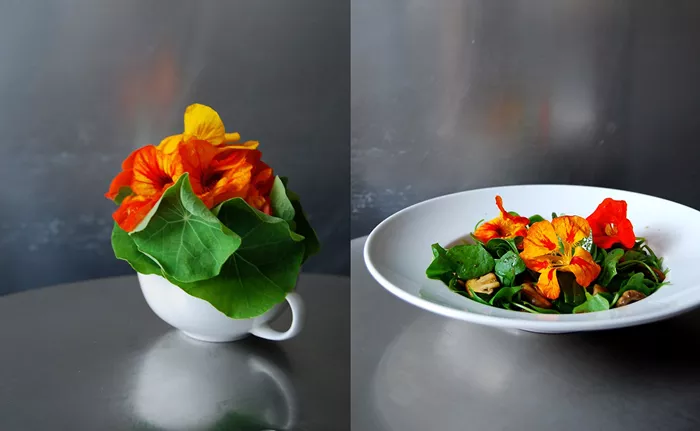Nasturtium, belonging to the genus Tropaeolum, is a vibrant and versatile flower that has captured the attention of gardeners and culinary enthusiasts alike. Native to South America, these flowers are not only visually striking with their bright colors but also offer a delightful peppery flavor that enhances various dishes. Commonly found in gardens, nasturtiums are celebrated for their ability to attract pollinators while providing an edible component that can elevate culinary creations.
Can You Eat Nasturtium Flowers?
Yes, nasturtium flowers are entirely edible, and they are often used in salads, garnishes, and other culinary applications. The entire plant is consumable, including the leaves and immature seed pods. The flavor profile of nasturtium is reminiscent of pepper and radishes, with the flowers being milder compared to the leaves and seeds. This unique taste makes them a favorite among chefs looking to add a splash of color and flavor to their dishes.
Uses of Nasturtium Flowers
Nasturtium flowers can be used in a variety of ways:
Salads: Their bright colors make them an attractive addition to salads.
Garnishes: Use them to garnish soups, appetizers, or main dishes for a pop of color.
Stuffed Flowers: The blossoms can be stuffed with cheese or other fillings for a delightful appetizer.
Herbal Infusions: Nasturtium leaves and flowers can be steeped in hot water to make a refreshing herbal tea.
Condiments: They can be blended into sauces or made into flavored butter.
Nasturtium Flower Varieties
Nasturtiums come in numerous varieties, each offering unique colors and characteristics. Some popular varieties include:
Tropaeolum majus: The most common garden variety with large, funnel-shaped flowers in shades of orange, red, and yellow.
Nasturtium ‘Empress of India’: Known for its deep crimson flowers and compact growth habit.
Nasturtium ‘Alaska Hybrids’: Features striking foliage with white spots alongside colorful blooms.
Nasturtium ‘Jewel of Africa’: A climbing variety that produces vibrant marbled flowers.
Appearance and Characteristics of Nasturtium Flowers
Nasturtium flowers are characterized by their funnel shape and spurred petals. They typically measure 2-3 inches wide and bloom in colors ranging from creamy white to deep red. The leaves are round and resemble lily pads, adding to the plant’s ornamental appeal. This combination of colorful blooms and lush foliage makes nasturtiums a popular choice for both ornamental gardens and edible landscapes.
Planting and Growing Nasturtium Flowers
Nasturtiums are relatively easy to grow, making them ideal for both novice and experienced gardeners. Here are some tips for planting:
- Soil: They thrive in well-drained soil with a pH range of 6.0 to 7.0.
- Sunlight: Full sun or partial shade is best for optimal growth.
- Watering: Moderate watering is necessary; avoid overwatering as it can lead to root rot.
- Spacing: Space plants about 12-18 inches apart to allow for sprawling growth.
Nasturtiums can be direct-seeded into the garden after the last frost or started indoors.
Medicinal Properties of Nasturtium Flowers
Beyond their culinary uses, nasturtiums have several medicinal properties. Traditionally used in various cultures, they are believed to possess:
- Antimicrobial properties: Used topically for minor cuts and scrapes.
- Rich in Vitamin C: Supports immune health.
- Anti-inflammatory effects: May aid in reducing inflammation within the body.
In Peru, nasturtium leaves are brewed into tea as a remedy for respiratory issues, while in Ayurvedic practices, they are used for oral health.
Flower Language of Nasturtium Flowers
In the language of flowers, nasturtiums convey various meanings based on their color:
Red nasturtiums symbolize courage and strength.
Yellow nasturtiums represent joy and merriment.
Orange nasturtiums signify creativity and energy.
These meanings were particularly significant during the Victorian era when flowers were often used to convey hidden messages.
Fun Facts About Nasturtium Flowers
Here are some interesting tidbits about nasturtiums:
The name “nasturtium” comes from Latin words meaning “twisted nose,” referring to the spicy flavor that may cause a slight reaction when tasted.
They were introduced to Europe by Spanish explorers in the 1500s and became popular in royal gardens.
Nasturtiums are known as companion plants; they can deter pests from other plants while attracting beneficial insects like bees.
Other Edible Wild Flowers to Consider
If you enjoy exploring edible flowers beyond nasturtiums, consider these options:
Borage: Known for its star-shaped blue flowers with a cucumber-like flavor.
Calendula (Pot Marigold): Bright orange petals that add color and mild flavor to dishes.
Chive Blossoms: Delicate purple flowers with a mild onion flavor perfect for salads or garnishes.
These edible blooms can enhance your culinary experiences while adding beauty to your garden.
Conclusion
Nasturtium flowers offer an exquisite blend of beauty, flavor, and versatility. From their vibrant appearance in gardens to their delightful taste in culinary creations, they hold a special place among edible flowers. Whether you choose to grow them for their ornamental value or incorporate them into your meals, nasturtiums bring joy not only through their visual appeal but also through their rich history and health benefits. Embrace these charming blooms in your garden and on your plate!


